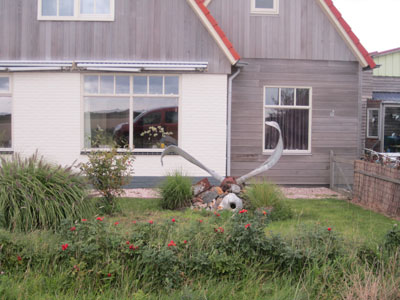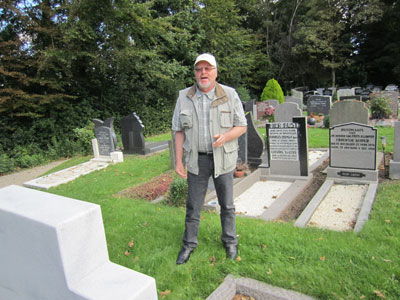Texel: Europe’s last WWII battlefield
This item appears on page 25 of the October 2014 issue.
I traveled to the Dutch Island of Texel (pronounced “Tessel”) in September 2012 to do research for a book I was writing.
Texel is the site of an unusual battle in which troops fighting under Hitler turned on one another and continued a vicious battle, even after Germany’s unconditional surrender ended World War II in Europe.
Today, Texel’s summer beaches are busy with Europeans, who take the short ferry ride from Den Helder to swim, sun, kite-board and surf off the 12-mile-long island. It has a large wildlife refuge and wonderful bicycle paths and is home to the famous Texel sheep.
My trip began with a direct flight on Delta Air Lines from Salt Lake City to Paris, where I stayed for five days at one of my favorite Left Bank hotels, Best Western Trianon Rive Gauche (1 rue de Vaugirard, 75006 Paris, France; phone +33 1 43 29 88 10, www.hoteltrianonrivegauche.com). I paid €188 (near $250) a night.
From there, I took a train to Brussels to visit the Royal Military Museum (Parc du Cinquantenaire 3, 1000 Brussels; www.museedelarmee.be). With everything from ancient pikes and armor to modern tanks and jet fighters, this is the best war history museum I’ve ever experienced. Admission was free.
Using Rail Europe (800/622-8600, www.raileurope.com) to obtain my train tickets, I moved on to Amsterdam, then changed trains and rode for 90 minutes until reaching Den Helder and the ferry to Texel.
During the brief ferry trip, I made the acquaintance of Els Koorn, who taught kindergarten in the town of De Koog, my destination on the island. In a wonderful gesture, Els and her husband, Tymen, invited me to dinner.
When I told them that I was there to research the so-called Georgian uprising of WWII, they knew just the man I should turn to, Gelein Jansen, a native of Texel who has studied this fascinating slice of war history for many years.
Gelein picked me up the next day from my hotel and we began an eerie trip back in time. He filled me in on the background.
In 1943, Hitler formed the 882nd Queen Tamara Infantry Battalion, consisting of about 400 Germans and 800 Georgians. Some of the latter were turncoats from the Russian Army. They had initially been ordered to fight anti-German partisans in Poland but on Feb. 6, 1945, were shifted to Texel, where Hitler believed the Allies might make another landing. The Georgians were put to work building bunkers and gun emplacements.
We first drove into a thick forest, where Gelein stopped the car and asked me to look for a bunker. I slowly made out the concrete walls and curved sides of what once had been a storage site for ammunition. It was mossy and overgrown with vines and brush. A chill went up my spine.
This 2,000-acre wood held 50 such bunkers, Gelein told me. Soon he was pointing them out at regular intervals. Most were made of rough concrete, but a few were brick. Some had been converted to use by farmers. Several had been attacked with graffiti.
By early April 1945, the Georgians on Texel could sense how the winds of war were blowing. The Allies were closing in on Berlin and the war would soon end. Canadian troops were already advancing toward Texel, and German surrender was at hand. The Georgians believed that a landing by Allied troops in Holland was imminent.
The Georgians’ great fear was that, once in Allied hands, they would be turned over to the Russians. Stalin’s treatment of any of these once-Soviet subjects who had fought for Germany consisted of a bullet in the back of the neck. Even Russians who were German prisoners were sometimes executed or, at least, sent to the gulags.
The Georgians decided to revolt against the Germans who commanded them.
Gelein took me to the barracks where the revolt began, now a dairy farm.
It was there, shortly after midnight on April 6, 1945, that the Georgians turned on the Germans. While the Germans were sleeping, they killed several hundred of their German masters, using bayonets and knives. The Dutch underground quickly moved to help the Georgians, and many islanders took up arms against the German occupiers.
Sporadic shots could be heard throughout the night and for the next few days as the Georgians and the Dutch resistance found German holdouts.
Meanwhile, some surviving Germans fled the island, soon returning with about 2,000 German riflemen.
Gelein explained that the revolt staggered to a halt when the Georgians failed to capture artillery batteries at either end of Texel. These batteries fired on Georgian positions while the freshly imported German troops combed the island, in dragnet style, flushing out and killing the Georgians like hunted quail.
Any captured mutineers were ordered to dig their own graves and remove their German uniforms before being executed. This continued for weeks as more Georgians were captured or killed.
Germany’s unconditional surrender in World War II came on May 8, yet not until May 20 did newly arrived Canadian troops pacify “Europe’s last battlefield.”
We visited the Georgian cemetery, Loladze, in Den Burg, where I picked a fresh rose from the well-kept burial ground. Fifty dead Georgians lay under each row of roses. There were perhaps a dozen rows as well as a monument in Dutch and Georgian.
The German dead were initially buried on Texel, but in 1949 they were moved to Ysselsteyn military cemetery in the Netherlands.
Gelein also showed me the marsh where the bodies of Dutch resistance fighters were thrown after being executed by the Germans.
The 228 Georgians who survived by hiding from the German troops were eventually turned over to Soviet authorities under an agreement with the Allies. Almost all of the Georgians went into Soviet gulags.
In the mid-1950s, perhaps because of Stalin’s death in 1953, those Texel Georgians still alive were “rehabilitated” and allowed to return home.
As we drove along the roads of the island, Gelein pointed out detritus left over from the war — the bent propeller of an American P-38 fighter and the engine of a British Beaufort torpedo bomber pulled up in fishing nets.
After a wrenching day of viewing bunkers, gun emplacements and fields where the battles had taken place, and after reliving those moments of 67 years before, I was ready for an early evening.
However, Els and Tymen had other plans for me. That evening in De Koog, there was a competition taking place between chefs, a sort of street fair with samplings of all the food offerings available on the island. My favorites were the succulent Texel lamb chops, said to be flavored by the salty grass of the island.
My 3-night stay at Hotel Tesselhof (Kaapstraat 39, De Koog, Texel 1796 AE, The Netherlands; phone +31 222 317 370, www.hotel
tesselhof.com) came to €260 ($343). Meals cost about another $100 during my stay on the island.
I tipped Gelein Jansen $150. Although his English is somewhat broken, I highly recommend him as a guide. Considered the island’s historian, he does charge a negotiable fee; email gelein@kpnplanet.nl.*
The island’s population swells on summer weekends, so I suggest visiting in May, June or September.
To learn more about the Texel Uprising of 1945, visit en.wikipedia.org/wiki/Georgian_uprising_on_Texel.
JIM URE
Salt Lake City, UT
* ITN emailed Mr. Jansen, who replied, “In 2015, for the first time ever, Texel will observe a memorial day on the 20th of May, the 70-year anniversary of the last battle in the Netherlands, when we got our freedom back in Texel. Several activities are scheduled. Normally, we celebrate the national Remembrance Day only on May 5.


